AMD FX-9590 and FX-9370 Review: Socket AM3+ Platform’s Swan-song

AMD roadmap tells us about the company had finished evolution of Socket AM3+ platform and FX processors. Vishera CPUs based on Piledriver microarchitecture is the last CPUs for this platform. We have tested the last additions in this lineup: eight-core FX-9370 and FX-9590 with monstrous TDP.
For the last few years AMD has been quite successfully selling FX series processors which didn’t incorporate a graphics core and were the company’s fastest offers. Ideologically similar to Intel’s Core Extreme Edition products, these chips were quite popular among gamers and overclockers who installed flagship discrete graphics cards in their configurations. The FX series owed its success to AMD’s reasonable price policy as well as to good performance in multithreaded applications but now AMD is changing its focus from the fast multicore FX series solutions to more affordable APUs, a significant decision reflecting the company’s change of priorities.
Still, even though AMD is going to put its best efforts into developing and promoting APUs (which indeed come out better than AMD’s top-end desktop processors), the FX series will not be phased out right now. There are no plans for new FX models but the older ones, based on the 32nm Vishera design from 2012, will keep on selling for the next few quarters. AMD expects users to be still interested in the FX series despite its respectable age. That’s why a few months ago the company added a couple of elite Socket AM3+ products into the line-up with clock rates reaching up to 5 GHz. These are the FX-9370 and FX-9590 models. AMD’s unwillingness to introduce new manufacturing technologies and microarchitectures in the FX series makes these products quite specific. Particularly, their high TDP limits their compatibility with the infrastructure AMD had been building for years.
The new processors took a long time to reach end-users. Considering the compatibility issues, AMD at first tried to distribute the FX-9370 and FX-9590 via select partners from among system integrators, so that the new CPUs would come to the user as part of a ready-made high-end computer. This didn’t work because the system integrators were not eager to deal with the FX-9370 and FX-9590 due to their high price and insufficiently high performance. So eventually AMD had to reposition these two models as ordinary Socket AM3+ products that continue the FX series in a logical way. The special status of the FX-9370 and FX-9590 used to be emphasized by their low availability, limited compatibility with mainboards and coolers, and high price (up to $1000), but now two of these factors have become irrelevant as the CPUs are available from many resellers and at more affordable prices. So again, AMD now wants to present the FX-9370 and FX-9590 as a normal continuation of the FX series. It is from this point of view that we are going to discuss these products in our today’s review.
AMD FX-9370 and FX-9590 in Detail
Although their model names start with the number 9, the FX-9370 and FX-9590 are not fundamentally different from their predecessors. They are based on the same Vishera design as the models we are already familiar with such as the FX-8350. Each has eight cores with Piledriver microarchitecture combined into dual-core modules. Manufactured on 32nm tech process, they have a shared 8MB L3 cache and are compatible with the Socket AM3+ platform. The higher clock rates are just a kind of official overclocking. Even the core stepping hasn’t changed since the FX-8350: the FX-9370 and FX-9590 are based on the well-known OR-C0 core.
Thus, the higher clock rates are in fact the main difference of the new processors from the earlier Socket AM3+ products. The frequency growth is quite substantial: the FX-9370 and FX-9590 are 10% and 17.5% faster than the FX-8350 in terms of clock rate. That’s why AMD touts the FX-9590 as the first processor capable of working at 5 GHz. That’s true: it can indeed reach that clock rate in the turbo mode.
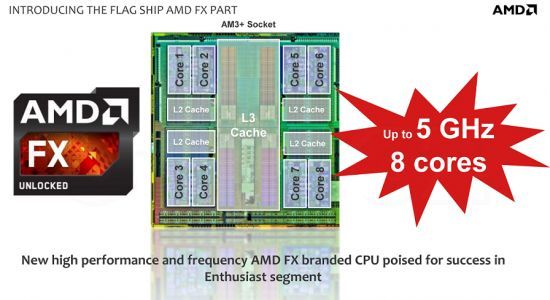
This substantial overclocking – without any deep technical improvements – has called for some additional tweaking. We mean the higher voltage, which is increased by 0.1 volts compared to the earlier FX series processors. It is no wonder then that the FX-9370 and FX-9590 dissipate more heat. Their peak heat dissipation is specified at 220 watts, which is 95 watts higher compared to any earlier Socket AM3+ processor.
The following table helps compare the FX 9000 series products with the ex-flagship FX-8350:
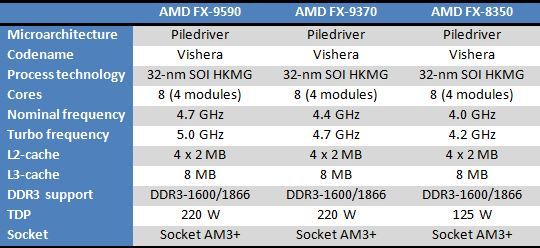
Besides that, the new FX-9370 and FX-9590 differ in how their Turbo Core technology works. Considering that these CPUs dissipate quite a lot of heat even without any overclocking, they are not eager to switch to the higher-frequency modes. FX series CPUs used to work in Turbo mode for long periods of time when fewer than half of their x86 cores were loaded, but the FX-9370 and FX-9590 only increase their clock rate occasionally and at low loads. It is safe to assume that the standard clock rate of the FX-9370 and FX-9590 is indeed their main operating clock rate.
The new processors from AMD generating much more heat than any other, some users might be wary of installing them into their desktop computers. There’s nothing to worry about, actually. First of all, today’s top-end graphics cards may dissipate even more heat without any problems for the computer. And secondly, many modern mainboards and coolers are designed for overclockers and have a large safety margin. In fact, if your Socket AM3+ platform can work with regular CPUs overclocked to 5 GHz, it will also be compatible with AMD’s 220W products.
Anyway, mainboard makers have not adapted all of their products to support the FX-9370 and FX-9590. The resulting compatibility list is rather short, including eight products from three brands:
- ASRock 990FX Extreme9
- ASRock Fatal1ty 990FX Professional
- ASUS Crosshair V Formula-Z
- ASUS Sabertooth 990FX R2.0e
- ASUS M5A99FX Pro R2.0
- Gigabyte GA-990FXA-UD3 Rev4.0
- Gigabyte GA-990FXA-UD5 Rev3.0
- Gigabyte GA-990FXA-UD7 Rev3.0
However, if an overclocker-friendly mainboard lacks official support for the FX-9370 and FX-9590, it might still be compatible with them. It just won’t support Turbo Core technology with these CPUs.
It is even simpler with coolers. AMD says that the FX-9370 and FX-9590 call for water cooling and sells them without any coolers at all. However, ordinary air coolers seem to be quite enough to handle the 220W models of the FX series. For example, we tried to cool our FX-9590 with a Noctua NH-U14S, a regular single-section tower-design cooler for a 140mm fan, and had no problems at all. The CPU didn’t overheat and even had a comfortable temperature at high multithreaded loads. According to the mainboard’s sensor, the peak temperature of the CPU was 70°C.
As we’ve noted above, AMD doesn’t position its FX-9370 and FX-9590 as special or elite products anymore. That’s why their prices are quite affordable now. According to the official price list, the FX-9590 costs $306 whereas the FX-9370 costs $224. AMD clearly wants to pit the FX-9590 against the Core i7-4770K and the FX-9370 against the Core i5-4670K. AMD’s products are somewhat cheaper but have higher heat dissipation. AMD thinks that this positioning is correct in terms of performance, suggesting that the Socket AM3+ platform remains quite competitive today.
Still, if you choose the Socket AM3+ platform, you should be aware of its downsides which are not CPU-related. First of all, the platform lacks modern chipsets. It means it doesn’t support PCI Express 3.0 while the mainboards have to be equipped with lots of additional controllers, USB 3.0 in the first place, and cost a lot as the consequence. Secondly, the Socket AM3+ ecosystem has no clear perspectives right now. It is very likely that there will be no more CPUs for that socket. The FX-9370 and FX-9590 are the ceiling that’s not going to be lifted up.
Testbed and Methods
This test session is focused on AMD’s FX 9000 series processors:
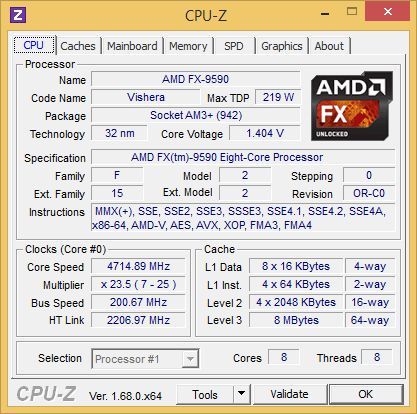
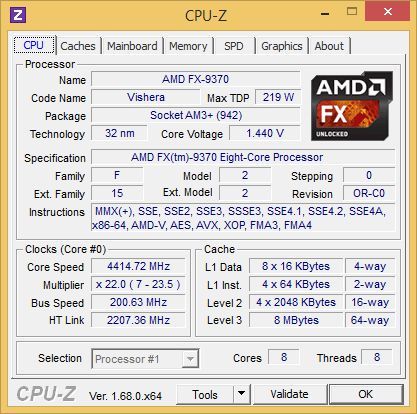
We will compare them with their direct opponents (in AMD’s opinion): Core i7-4770K and Core i5-4670K. These Haswell-based CPUs come at similar prices as AMD’s CPUs. Besides them, we also include the previous flagship Socket AM3+ processor AMD FX-8350.
Here is a full list of hardware components we will use for our test session:
- CPUs:
- AMD FX-9590 (Vishera, 8 cores, 4.7-5.0 GHz, 4x2MB L2, 8MB L3)
- AMD FX-9370 (Vishera, 8 cores, 4.4-4.7 GHz, 4x2MB L2, 8MB L3)
- AMD FX-8350 (Vishera, 8 cores, 4.0-4.2 GHz, 4x2MB L2, 8MB L3)
- Intel Core i7-4770K (Haswell, 4 cores + HT, 3.5-3.9 GHz, 4x256KB L2, 8MB L3)
- Intel Core i5-4670K (Haswell, 4 cores, 3.4-3.8 GHz, 4x256KB L2, 6MB L3)
- CPU cooler: Noctua NH-U14S
- Mainboards:
- ASUS M5A99FX Pro R2.0 (Socket AM3+, AMD 990FX + SB950)
- Gigabyte Z87X-UD3H (LGA1150, Intel Z87 Express)
- System memory: 2x8GB G.Skill [TridentX] F3-2133C9D-16GTX DDR3-2133 SDRAM (9-11-11-31)
- Graphics card: NVIDIA GeForce GTX 780 Ti (3 GB/384-bit GDDR5, 876-928/7000 MHz)
- Storage: Intel SSD 520 240GB (SSDSC2CW240A3K5)
- Power supply: Corsair AX760i (80 Plus Platinum, 760 W)
We carry our tests out in Microsoft Windows 8.1 Enterprise x64 with the following drivers:
- AMD Chipset Drivers 13.12
- Intel Chipset Driver 9.4.0.1027
- Intel Management Engine Driver 9.0.2.1345
- Intel Rapid Storage Technology 12.9.0.1001
- NVIDIA GeForce Driver 332.21
Performance
General Performance
As usual, we use the Bapco SYSmark 2012 suite to estimate performance in everyday computing tasks. It emulates a user working in popular office and digital content creation and processing applications. The test produces a single score indicative of the computer’s average performance across different applications. After the launch of Windows 8, SYSmark 2012 got updated to version 1.5 and we use the updated version for our tests.
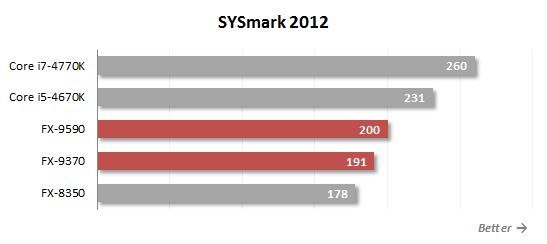
Comparing the AMD FX-9590 with the previous flagship FX-8350, the performance has grown by about 12% without much effort. AMD achieves that by having merely increased the clock rate. Intel has to introduce new microarchitecture to ensure such performance benefits whereas AMD just ignores such factors as power consumption and heat dissipation.
On the other hand, the Vishera-based CPUs are still slower than the Core i5 and Core i7 series. The Piledriver microarchitecture isn’t very efficient in everyday applications which cannot run smoothly in eight computing threads. Low single-threaded performance is the weak spot of AMD’s processors, which makes them inferior to Intel’s products in general-purpose computers.
Now let’s take a closer look at the performance scores SYSmark 2012 generates in different usage scenarios. The Office Productivity scenario emulates typical office tasks, such as text editing, spreadsheets, email and web-surfing. This scenario uses the following applications: ABBYY FineReader Pro 10.0, Adobe Acrobat Pro 9, Adobe Flash Player 10.1, Microsoft Excel 2010, Microsoft Internet Explorer 10, Microsoft Outlook 2010, Microsoft PowerPoint 2010, Microsoft Word 2010 and WinZip Pro 14.5.
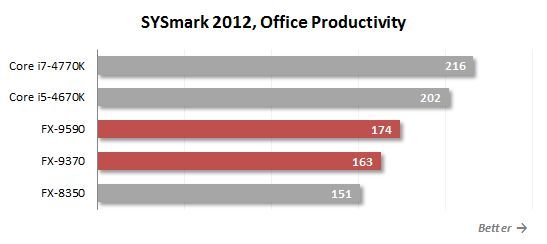
The Media Creation scenario emulates the creation of a video clip out of prepared materials (digital images and videos) using popular tools from Adobe: Photoshop CS5 Extended, Premiere Pro CS5 and After Effects CS5.
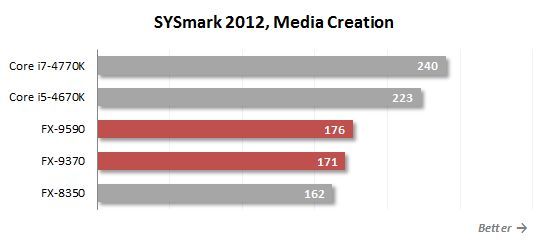
Web Development is a scenario that emulates website authoring. It uses the following applications: Adobe Photoshop CS5 Extended, Adobe Premiere Pro CS5, Adobe Dreamweaver CS5, Mozilla Firefox 3.6.8 and Microsoft Internet Explorer 10.
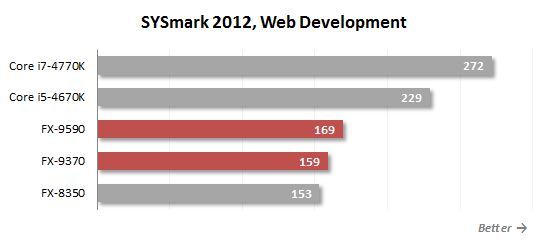
The Data/Financial Analysis scenario is concerned with statistical and market analysis by means of Microsoft Excel 2010.
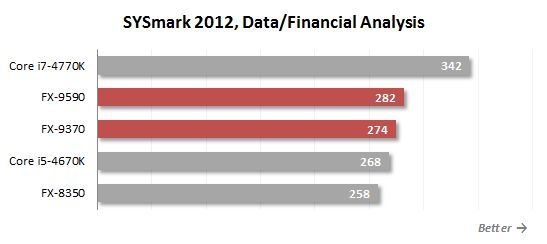
The 3D Modeling scenario is about creating 3D models and rendering static and dynamic scenes using Adobe Photoshop CS5 Extended, Autodesk 3ds Max 2011, Autodesk AutoCAD 2011 and Google SketchUp Pro 8.
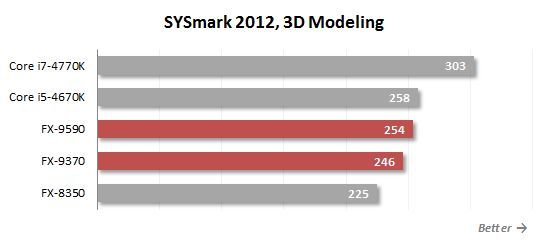
The last scenario, System Management, creates backup copies and installs software and updates. It involves several different versions of Mozilla Firefox Installer and WinZip Pro 14.5.
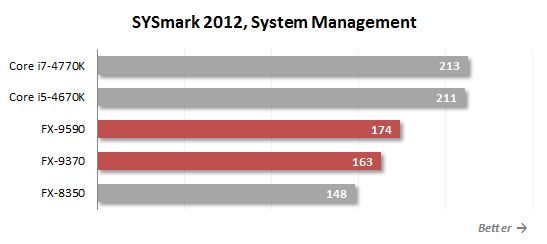
AMD’s new processors are the most impressive under the multithreaded loads of the Data/Financial Analysis and 3D Modelling scenarios. Applications of this kind can effectively run in several parallel threads, so it is no wonder that the FX-9590 can compete with the Core i5-4670K. But these are just a few cases and, moreover, there is no talking about challenging the Core i7. In other words, AMD seems to overestimate its new products, especially when it comes to typical usage scenarios such as office work, content authoring, web applications, etc.
Now let’s check out the dual-core Vishera-based processors from AMD in specific applications, starting from games.
Gaming Performance
As you know, it is the graphics subsystem that determines the performance of the entire platform in the majority of contemporary games if the platform has a fast enough processor. Therefore, we select the most CPU-dependent games and measure the frame rate in two test modes. For the first mode we use lower resolutions and disable full-screen antialiasing, so we could see how well the processor can cope with gaming loads in general. This provides some insight into how the tested CPU is going to behave in the nearest future when it is accompanied with faster graphics cards. The second test mode refers to real-life settings: Full HD and maximum FSAA. In our opinion, these results are no less interesting as they demonstrate clearly the level of performance we can expect from contemporary processors today.
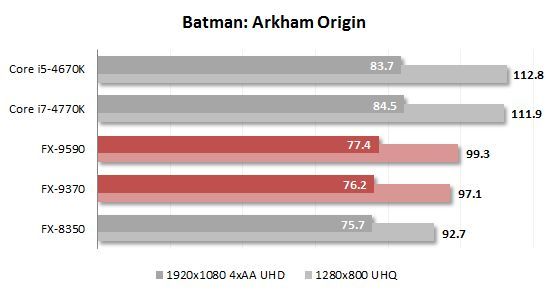
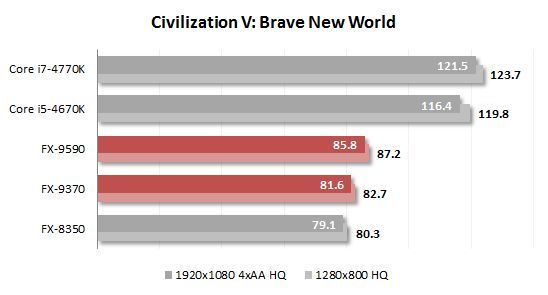
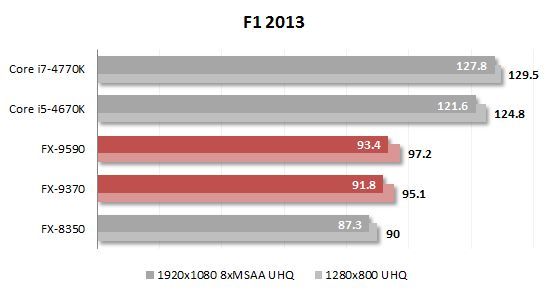
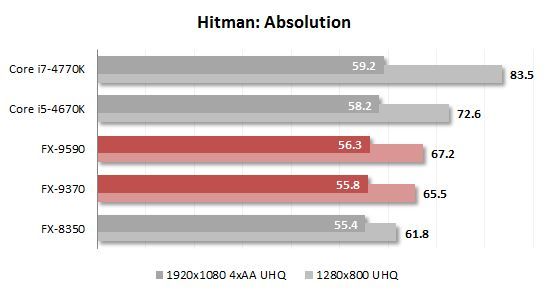
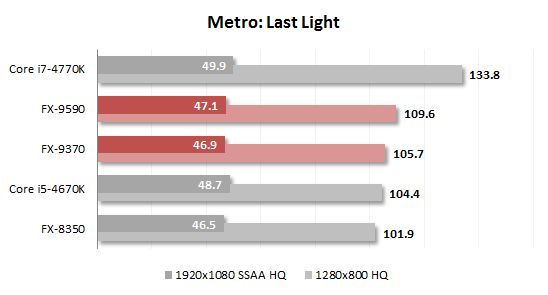
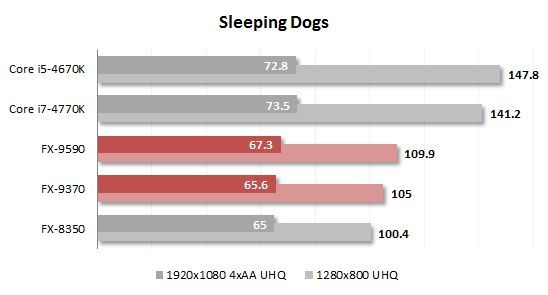
Gaming performance is something that we’ve always blamed AMD’s processors for. Unfortunately, the higher clock rates of the FX-9590 and FX-9370 can’t do anything about that. There is not a single game on our test program, which includes the most CPU-sensitive gaming applications, where the flagship FX-9590 can challenge the Core i7-4770K. What is especially bad for AMD, the difference in performance is quite obvious not only at the low resolutions but also in the popular Full-HD mode with maximum visual quality settings.
So it looks like increasing the clock rate of processors with Piledriver microarchitecture can’t make them attractive as gaming solutions. The problem is rooted in the microarchitecture itself which has a relatively low efficiency in terms of performance per core. Even though modern games can run in multiple computing threads, gaming loads cannot be paralleled as easily as encryption or 3D rendering loads. The game engine still runs as a single thread, so single-threaded performance remains most important for a CPU that’s going to be used in gaming configurations. Metro: Last Light and Hitman: Absolution are good examples of our point: both can load each of the eight cores of the top-end FX series processors, yet the frame rate remains rather low.
We’ll finish our gaming tests by running the popular synthetic benchmark 3DMark.
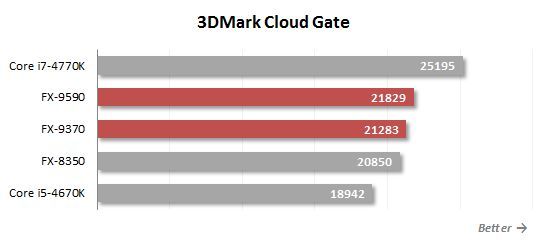
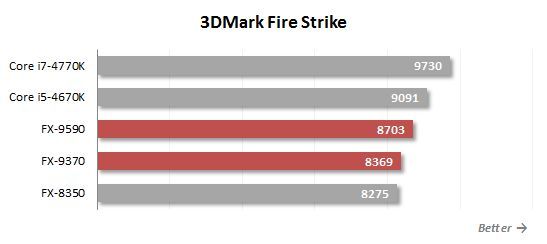
Although 3DMark is optimized for multicore CPU architectures, the top-end Vishera-based processors fall behind the Core i7-4770K, despite higher clock rates (by as much as 1 GHz) and twice as many x86 cores. Even if games get more efficiently adapted to multicore CPUs in the future, the FX series will hardly show anything exceptional in them. So, if you’re building a modern top-end gaming configuration, you should prefer an Intel solution, especially as the Socket AM3+ platform doesn’t support PCI Express 3.0.
Application Tests
In Autodesk 3ds max 2014 we benchmark the speed of mental ray rendering of a complex 3D scene.
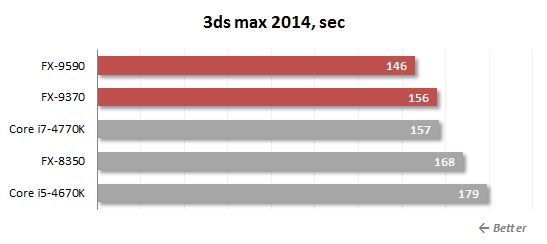
The final rendering is a type of application that can run easily on multiple processing cores. Most of its computations are integer. AMD’s multicore FX series CPUs are especially effective at such loads, so it is no wonder that the FX-9370 and FX-9590 deliver high performance. Being 7% and 15% faster than their predecessor FX-8350, the new processors from AMD compete successfully with the top-end LGA1150 products. The FX-9370 is about as fast as the Core i7-4770 whereas the flagship FX-9590 is 8% ahead of the fastest Haswell-based CPU.
In Adobe’s After Effects CC we measure the speed of classic rendering of a 3D video with a set of filters and special effects.
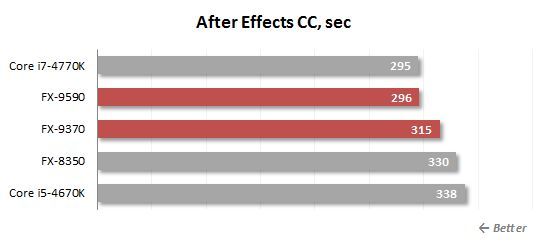
Rendering video effects in this Adobe application is somewhat different from 3D rendering but can also be easily carried out in parallel on multiple processing cores. The FX-9370 and FX-9590 are not as impressive as in the previous test. Still, the FX-9370 is ahead of the comparably priced Core i5-4670K whereas the FX-9590 is as good as the flagship quad-core Haswell with Hyper-Threading support.
The performance in Adobe Premiere Pro CC is measured as the time it takes to render a Blu-ray project with HDV 1080p25 video into H.264 format and apply special effects to it.
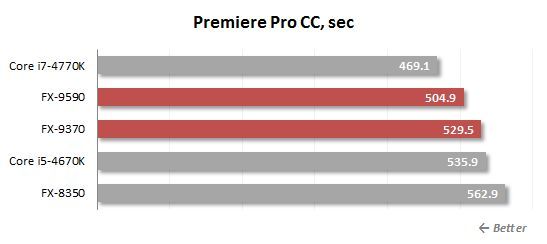
As a matter of fact, AMD’s Socket AM3+ processors are good enough for a broad range of applications that create high multithreaded loads but such applications are usually meant to run on workstations. Adobe Premier Pro CC is a good example. The FX-9370 and FX-9590 don’t show anything exceptional here but, being 6% and 11% ahead of the FX-8350, they are quite comparable to the Haswell-based Core i5 and Core i7 products. To be precise, the FX-9370 and FX-9590 are faster than the Core i5-4670K but slower than the Core i7-4770K, which agrees with AMD’s official pricing.
The test scenario for Adobe Photoshop Lightroom 5.3 includes post-processing and exporting into JPEG format of two hundred 12-megapixel RAW images captured with a Nikon D300.
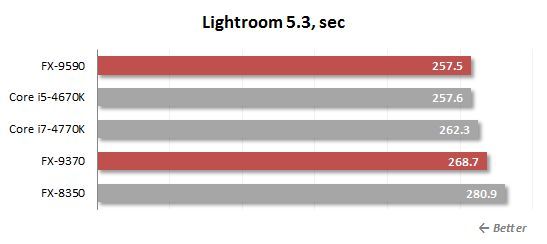
Batch-processing of photographs is also an appropriate task for AMD’s Vishera-based CPUs. Working at increased clock rates, the new FX-9370 and FX-9590 handle this job as efficiently as the fastest LGA1150 products.
We benchmark performance in Adobe Photoshop CC using our custom test that is based on the Retouch Artists Photoshop Speed Test and consists of typical processing of four 24-megapixel images captured with a digital camera.
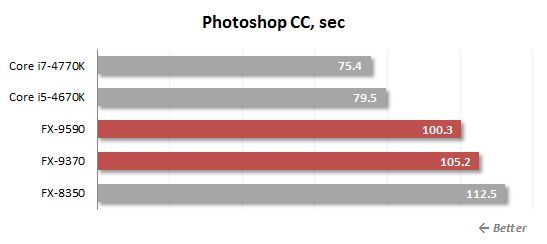
The FX-9370 and FX-9590 don’t find this test agreeable. The senior model falls behind the Core i5-4670K by as much as 26%. The fact is that Photoshop doesn’t always make good use of multiple processing cores. Moreover, this application often needs floating-point processing and the Piledriver design has only one floating-point subunit per each two x86 cores.
In our ABBYY FineReader 11.0 test we convert a scanned document with lots of formulas and images into a text format.
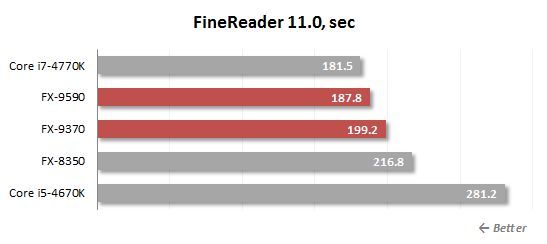
FineReader 11 is optimized for multicore CPUs, yet the top-end 8-core processors from AMD can’t match the quad-core Core i7-4770K with its Hyper-Threading technology. Anyway, the FX-9370 and FX-9590 deliver high performance here and seem to be absolutely worth the money.
The processors’ performance in cryptographic tasks is measured with the built-in benchmark of the popular TrueCrypt utility that uses triple AES-Twofish-Serpent encryption. Besides optimizations for multi-core CPUs, it supports the AES instructions.
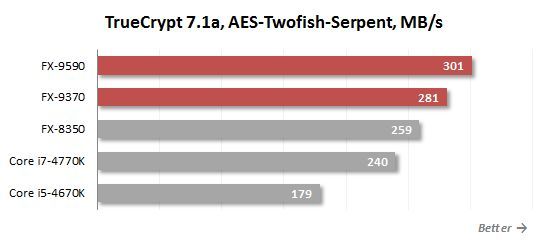
AMD processors have always been good at encryption. The FX-9370 and FX-9590 push the performance bar even higher up. They are 8% and 16%, respectively, faster than the FX-8350 and this performance boost helps them beat not only the Core i5-4670K but also the Core i7-4770K. The FX-9590 is up to 25% ahead of the senior Haswell-based model.
To test the processors’ performance at data archiving we use WinRAR 5.0. Using maximum compression rate, we archive a 1.7GB folder with multiple files.
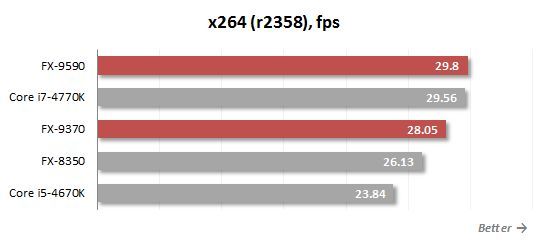
The WinRAR developers have managed to optimize their application for multicore CPUs, yet this is not enough for high archiving performance. Memory subsystem speed is important as well. AMD processors are inferior to their Intel opponents in cache latency as well as effective memory bandwidth. That’s why the 8-core FX-9370 and FX-9590 can only beat the quad-core i5-4670K here just because the latter lacks Hyper-Threading.
In order to measure how fast the tested CPUs can transcode video into H.264 format we used x264 FHD Benchmark 1.0.1 (64 bit). It measures the time it takes the x264 coder to convert an MPEG-4/AVC video recorded in 1920×1080@50fps resolution with default settings. The results have high practical value because the x264 codec is part of popular transcoding utilities such as HandBrake, MeGUI, VirtualDub, etc. We regularly update the coder used in this performance test. This time around, we use version r2358, which supports all contemporary instruction sets including AVX2.
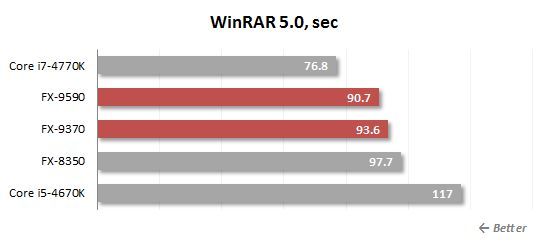
When encoding HD video, the AMD FX-9370 is 17% ahead of the Core i5-4670K whereas the FX-9590 is about as fast as the Core i7-4770K. So again, AMD’s new FX series processors deliver good performance in applications that are optimized for multicore CPUs.
Encoding video with a bare coder is hardly a real-life application, so we want to check out the speed of video transcoding with the popular free tool Freemake Video Converter 4.1.0. It uses the FFmpeg library and is based on the x264 coder too, but features certain optimizations. We disable CUDA for this test to create maximum load on the CPUs’ computing cores but enable DXVA optimizations.
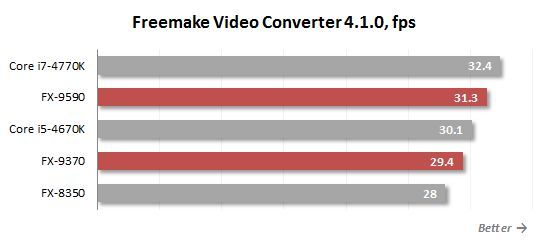
This picture is somewhat different from what we’ve seen in the previous test. Intel’s Core i5-4670K seems to be more confident, outperforming the FX-9370. In the same way, the FX-9590 is slightly slower than its market opponent Core i7-4770K.
Power Consumption
The performance benefits provided by the FX-9370 and FX-9590 are as good as expected but we are more interested in learning about their power consumption. On one hand, AMD has increased their TDP up to 220 watts but, on the other hand, it is hard to believe that a 17.5% increase in clock rate could provoke a 75% increase in power consumption and heat dissipation. The FX-9370 and FX-9590 have the same design as other Vishera-based products but work at higher voltage, so their power requirements must be higher, but we haven’t yet seen a CPU consuming up to 220 watts!
Of course, we tested the power requirements of our off-the-shelf samples of the FX-9370 and FX-9590 processors. The graphs below (unless specified otherwise) show the full power draw of the computer (without the monitor) from the wall socket. It is the total power consumption of all system components. The PSU’s efficiency is taken into account but our Corsair AX760i is a highly efficient 80 PLUS Platinum product, so its effect on the result is very small. The CPUs are loaded by running the 64-bit version of LinX 0.6.5 utility with support for AVX, AVX2 and FMA instructions. Moreover, we enable Turbo technology and all power-saving technologies to correctly measure the computer’s power draw in idle mode: Intel’s C1E, C6, Enhanced Intel SpeedStep and AMD’s Cool’n’Quiet.
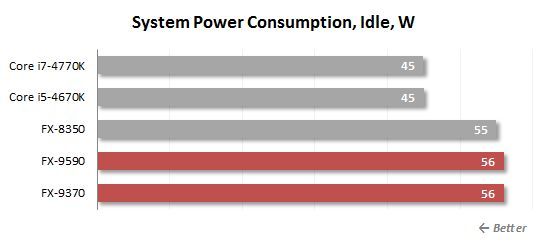
We’ve got a familiar picture in the idle mode. Every modern processor features advanced power-saving technologies which help it effectively shut down in this situation. So the diagram is indicative of the platforms’ rather than the CPUs’ power requirements, and the LGA1150 platform is obviously more economical. The Socket AM3+ platform uses a two-piece chipset with much higher power consumption than the senior LGA1150 chipset Z87. That’s why the Haswell-based configurations need less power at very low loads.
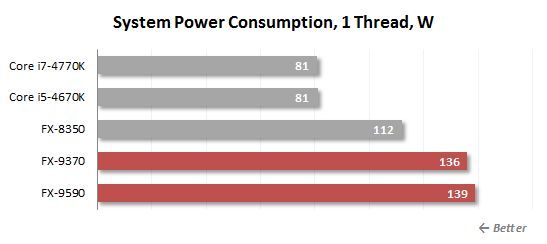
When it comes to single-threaded loads, the top-end Vishera-based CPUs consume 70% more power than their Haswell-based opponents. As you can see, their power requirements are much higher compared to the FX-8350. It is because the voltage of the FX-9370 and FX-9590 is additionally increased in Turbo mode, occasionally reaching up to 1.5 volts.
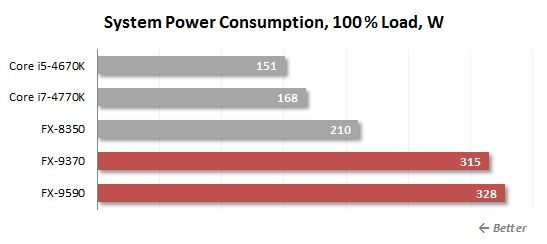
The FX-9370 and FX-9590 really need 100 to 120 watts more power than the FX-8350 at full load. As a result, the overall power draw of a configuration with a top-end Vishera-based CPU may be twice that of a Haswell-based configuration that would deliver the same performance and cost the same money. In other words, the FX-9370 and FX-9590 are far from economical and may have a very negative effect on the user’s electricity bills.
We can also note that the configurations with AMD’s top-end CPUs need even more power than Intel’s LGA2011 configurations with senior six-core CPUs, which means that the FX-9370 and FX-9590 are very poor in terms of per-watt performance.
Overclocking
As we’ve seen above, the FX-9370 and FX-9590 are already pre-overclocked by the manufacturer. Like an experienced overclocker, AMD not only increased the clock rate but also the voltage of its new FX 9000 series models. Still, we can hope that the FX-9370 and FX-9590 are manufactured out of semiconductor dies with the best frequency potential and thus can work at even higher clock rates than specified.
Before proceeding to our practical experiments, we want to remind you that a clock rate of 4.7 GHz is considered normal for an 8-core Vishera-based CPU under standard conditions. And this clock rate is the base one for the FX-9590! So while we can expect some overclocking potential from the junior FX-9370, the senior FX-9590 model is likely to be already working at its limit. GlobalFoundries’ 32nm tech process may have been improved over the year, yet the power consumption of the new CPUs suggests otherwise.
Now let’s see what we can expect from the FX-9370 and FX-9590 in terms of overclocking. We don’t want to set any records but only to find the clock rate at which our CPU can be used continuously. That’s why we don’t increase voltage much and use a dual-section tower-design cooler Thermalright Silver Arrow SB-E.
One more thing must be mentioned here. Considering their high heat dissipation, AMD played it safe and set very strict temperature limits for the FX-9370 and FX-9590. Their thermal throttling threshold is lower compared to other FX series processors, so you need an efficient cooler to keep their temperature at an acceptable level. That’s easier said than done, so the FX-9370 and FX-9590 turn out to be much harder to overclock than the similar 8000 series models.
With such unfavorable starting conditions, it is no wonder we couldn’t reach high results overclocking our top-end Vishera-based CPUs. The FX-9370 was stable at 4.7 GHz but we had to increase its voltage to 1.45 volts. At higher voltage the CPU would overheat at high loads and at lower voltage the LinX utility would abort with an error message. The peak temperature of the 4.7GHz FX-9370 during our stability check was 75°C according to the mainboard’s sensor.
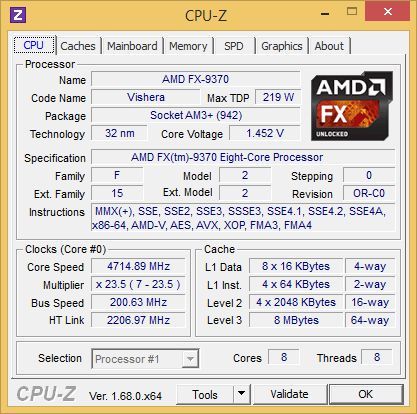
Thus, the FX-9370 has the same overclocking potential as regular 8-core FX series products like the FX-8350. The CPU is in fact pre-overclocked, so it can hardly be interesting for overclockers.
The faster FX-9590 could be sped up to 4.8 GHz, a mere 100 MHz above its default clock rate. The voltage was increased to 1.475 volts at that.
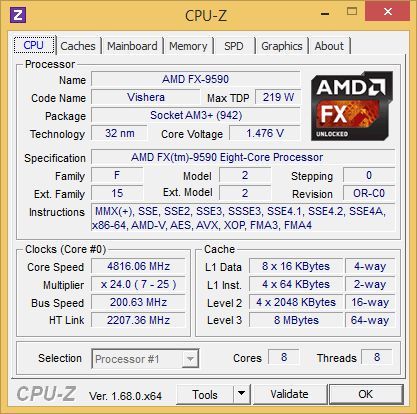
As with the other CPU, we were limited by thermal throttling. The CPU would get as hot as 75°C (according to the mainboard’s sensor) working at 4.8 GHz in our stability tests. When the temperature threshold was exceeded, the clock rate would drop down. We don’t think better results are possible as long as we use air cooling.
Summing up our overclocking experience, the FX-9370 and FX-9590 don’t seem to be overclocker-friendly. Their frequency potential is already used up by the manufacturer. So if you are interested in overclocking Socket AM3+ configurations, you may want to take a look at slower models such as the 8-core FX-8150 and FX-8350 which can be easily overclocked without such problems up to 4.6 to 4.8 GHz.
Conclusion
AMD has clearly left the market of top-performance x86 processors for the PC. The company has many plans concerning hybrid processors, energy-efficient microarchitectures for mobile devices, and ARM-based CPUs, but there are no conventional x86 CPUs for enthusiasts among them. We have to put up with the lack of alternatives. But before discontinuing its FX series AMD released the FX-9370 and FX-9590 models with increased clock rates, which emphasizes the key idea of the Bulldozer concept: a lot of relatively simple processing cores working at a high clock rate.
The FX-9370 and FX-9590 are not perfect due to the specifics of their microarchitecture, semiconductor die design and manufacturing process but we want to give them credit for delivering high performance in heavy multithreaded applications. Thanks to their high clock rates and eight (nearly full-featured) x86 cores, they are optimal for such jobs. If you use professional content authoring and processing suites for your work, you will find the FX-9370 and FX-9590 to be comparable to Intel’s senior Haswell-based products such as the Core i7-4770K and Core i5-4670K.
So we might recommend them for workstations if it were not for the fact that the FX-9370 and FX-9590 have no other advantages. Like their junior cousins, they are slow in applications which cannot use all of their x86 cores. They fall behind Intel’s CPUs at single-threaded loads. It means that AMD’s flagship CPUs are slow at everyday tasks such as office applications and popular 3D games.
Besides that, the FX-9370 и FX-9590 need many times as much power as their Intel opponents. You have to pay more for electricity and also need a better cooling solution. The overclocking potential is low as these CPUs are in fact pre-overclocked by the manufacturer to their very limit.
Summing everything up, the FX-9370 and FX-9590 lose to Intel’s top-end Haswell-based CPUs in their consumer properties and can hardly be interesting even for AMD’s loyal fans. AMD products can usually be used to build rather fast and cheap computers, but the senior Vishera-based CPUs are too expensive for that. They don’t offer anything that you don’t find in their more affordable FX series cousins except for the higher clock rates which don’t matter much in terms of practical performance. Moreover, all other FX series CPUs are Black Edition, so each of the less expensive 8-core AMD CPUs can be easily overclocked to about the same level as the FX-9370 or FX-9590.